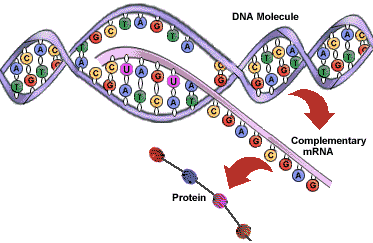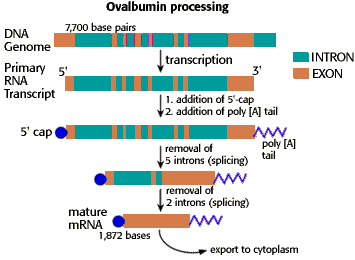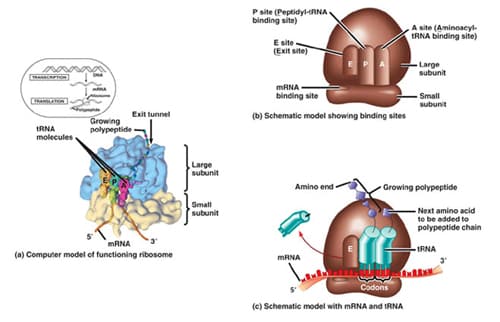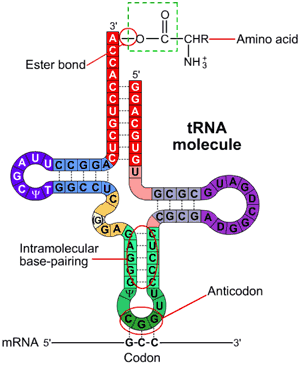Initiation:
– Upstream of the gene, RNA polymerase binds to a genes promoter region and unwinds the DNA double helix
Elongation:
– RNA polymerase starts building an mRNA, using the template strand of the DNA molecule, in the direction of 5’ to3’
– the strand that is not copied is called the coding strand
– the sequence of the mRNA is complementary to the template strand and identical to the coding strand, except it has uracil instead of thymine
Termination:
– RNA polymerase continues building the mRNA until it comes across a terminator sequence
– transcription ceases, the mRNA leaves the template strand and RNA polymerase is free to find another promoter region and transcribe another gene
Posttranscriptional Modification
– the newly synthesized mRNA molecule, the primary transcript must be modified before leaving the nucleus
– a 5’ cap is added to the start and a poly- A tail is added to the end of the primary transcript
– the 5’ cap plays a role in the initiation of translation and protects the mRNA from being damaged in the cytoplasm
Splicing
– DNA genes contain coding regions (called exons) and non coding regions (called introns)
– introns do not code for part of the protein and must be removed from the primary transcript; if these regions are translated the protein will not function properly
– spliceosomes cut out the introns and join the remaining exons together forming the mRNA transcript
– the mRNA transcript can now leave the nucleus and be translated into a protein
Protein Synthesis: Translation
– mRNA transcript enters the cytoplasm and binds to a ribosome
– the ribosome recognizes the 5’ cap of the mRNA transcript
Ribosomes:
– consist of two subunits, a large subunit of 60S and a small subunit of 40S
– the subunits clamp the mRNA between them, move along the mRNA in the 5’ to 3’ direction, and add new amino acids to a growing polypeptide chain
– mRNA is read three nucleotides at a time, and the phase in which this is done is called the reading frame
Transfer RNA (tRNA):
– tRNA deliver the correct amino-acids to the ribosome
– tRNA is a small, single-stranded nucleic acid whose structure resembles a cloverleaf
– one arm of the tRNA contains the anticodon which recognizes the codon of the mRNA
– the opposite arm to the anticodon carries an amino acid
– the recognition by tRNA of mRNA is facilitated by complementary base pairing
Initiation of the Polypeptide Chain:
– the first codon recognized by the ribosome is the start codon AUG
– AUG sets the correct reading frame for use by the ribosome
– ribosomes have two sites for tRNA: the A (acceptor site) and the P (peptide) site
– a) the tRNA the carries methionine enters the P site
Elongation of the Polypeptide Chain:
– b) the next tRNA enters the A site
– c) the amino acid on the A site tRNA becomes peptide bonded to the growing polypeptide chain
– d) the ribosome shifts over one codon causing the A site tRNA to move to the P site, the next tRNA enters the A site and the process continues
Termination of the Polypeptide Chain:
– translation ends when the ribosome reaches a stop codon (UGA, UAG and UAA)
– stop codons do not code for an amino acid, there are no corresponding tRNAs
– release factor releases the polypeptide chain from the ribosome and the two subunits fall off the mRNA





